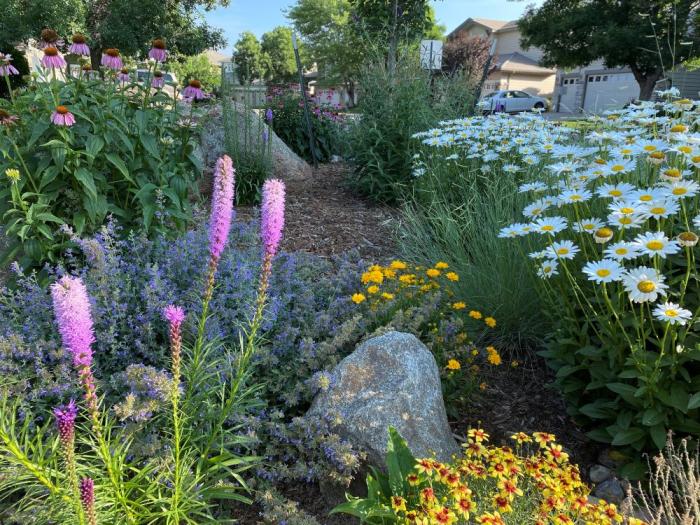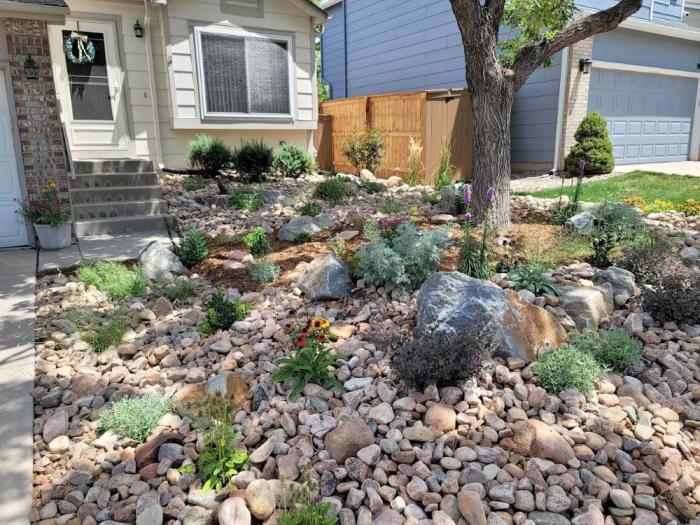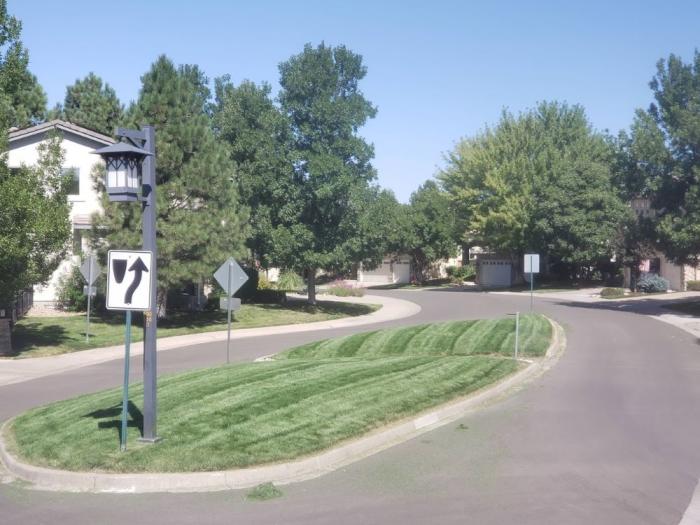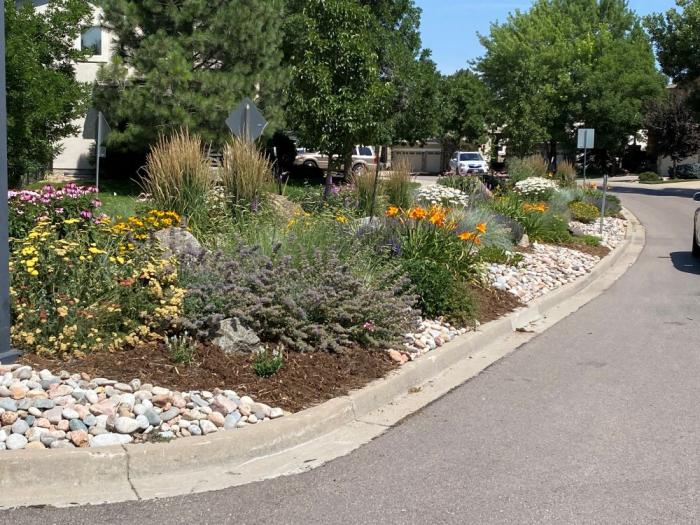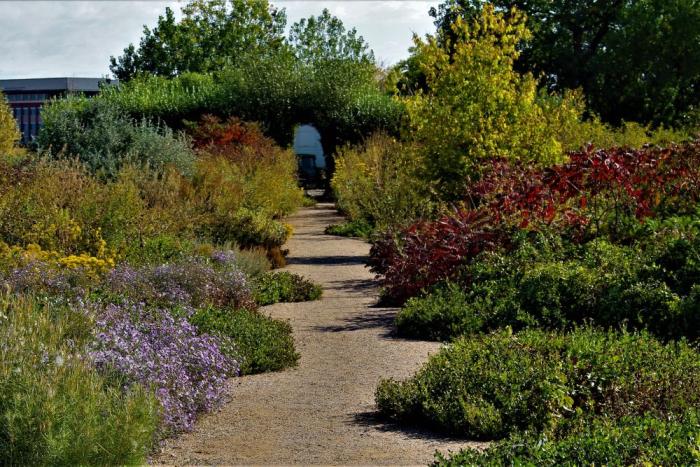It’s not so easy (anymore) being green
Homeowners associations, those rule-bound neighborhood organizations that residents seem to love or hate, conjure up a lot of images.
One of the most enduring: The HOA as the green grass enforcer, ensuring every lawn stays weed-free, well-watered and a dark shade of golf course emerald.
But years of drought, rising water bills, concern about climate change, state legislation and a growing ethic of conservation is beginning to change the picture for turf-addicted HOAs along Colorado’s Front Range.
And, in some cases, it’s HOAs themselves that are leading the way.
“Right now, it’s on the forefront of everybody’s mind — I want to save water,” said Scott Behnke, the owner of lawnCARE Solutions in Littleton, a company that works closely with HOAs to make community property more water-efficient.
“Everyone, from the HOA board members to property managers to residents, they’re all more conscientious about gallons consumed.”
A shift toward ‘ColoradoScape’
The new thinking at HOAs comes as Front Range communities, elected officials, water providers and homeowners themselves are advocating for a sea change in how Coloradans approach landscaping, especially in the semi-arid climate of the Front Range.
It is part of what appears to be a growing recognition for the need to shift away from thirsty Kentucky bluegrass and toward a more “ColoradoScape” — a diverse, water-smart spread of native plants, grasses and trees that brings shade, bird and pollinator habitat and fits more naturally into our Colorado climate.
See how Denver Botanic Gardens is transforming highly visible turf strip into a water-wise garden.
That the cultural shift is hitting even HOAs, long bound by often demanding rules to keep grass green even at the peak of summer heat, speaks to the significance of the moment.
“When I meet with HOAs, 99% of the time their question is ‘How are you going to bring our water use down?”’ said Chason Geister of Brighton-based Environmental Designs.
“It used to be, ‘How are you going to make our property look better?' But in the last three years, the question has turned to 'How I can bring their water use down?”’
Change has been building for years, and multiple factors have combined to bring it about. Those include:
- The rising cost of water, especially in some suburban areas where cities and utilities struggle with less dependent supplies.
- Aging landscapes, as many HOAs — now decades old — look to replace outdated irrigation systems and thirsty, overgrown or hard-to-maintain vegetation.
- State legislation that has made it more difficult for HOAs to require homeowners default to thirsty bluegrass lawns as their primary landscape and opened the door to less water-intensive options.
- Growing efforts within the Associated Landscape Contractors of Colorado, a trade organization that is highlighting and recognizing work that conserves water and promotes efficient landscapes.
- Programs at the state and local level to provide incentives and products to encourage property owners considering removing and replacing grass with native plants.
- Increasing awareness of long-term drought in the Colorado River Basin and the Front Range’s dependence on the Colorado River for water supplies.
- The increasing size and intensity of wildfires that have made the impacts of drought and climate change clear even to people who don’t typically pay attention to environmental issues.
The strongest motivation may be economic.
Landscapers and HOA board members say fast-rising water costs in some suburban areas are the primary driver to cut water demand.
“Cost was our original motivation,” recalled Sue Squibb, President of the Highland Walk Amenities Association, an HOA in Highlands Ranch.
“We were realistic; we knew that Centennial Water and Sanitation District had promised a series of rate increases. We knew if we didn’t find ways to cut our usage that we were looking at higher and higher bills.”
Economics, yes, but also a shift in thinking
And a gradual culture change — the collective understanding that Colorado’s Front Range, with its limited water supplies and semi-arid climate — also is behind a shift in thinking at HOAs.
Indeed, with a surge in efforts at state and municipal levels to create incentives to cut water use through landscape change, it’s hard for anyone inside or outside an HOA to miss the fact that finding ways to reduce outdoor irrigation is key to sustaining water supplies and quality of life in the Denver region and along the Front Range.
“What we are seeing in metro Denver, and along the Front Range — to be sure, across the Southwest — is the largest collective focus on landscape change we’ve ever experienced,” said Greg Fisher, who leads demand planning and efficiency for Denver Water.
“Motivations for action may vary but there’s no question that awareness of water supply challenges is on the rise.”
Denver Water has been at the forefront of the effort.
Last year it led the creation of a Colorado River Basin-wide Memorandum of Understanding. Participants pledged to cutting so-called “nonfunctional turf” — that is, grass used solely for decorative purposes — in their service areas by 30%, a major undertaking that will take years of work.
How one Denver Water staff member reinvented his yard, creating an "urban oasis."
So far, about 30 water providers stretching from the Front Range to Southern California have signed onto the MOU, including some of the largest water utilities in the Colorado River Basin.
At the local level, HOAs are beginning to take similar steps as the cost of maintaining acres of shiny green grass becomes unsustainable.
Some examples:
- The Highland Walk Amenities Association HOA has renovated hillside areas by replacing thirsty Kentucky bluegrass with native grass, relocated irrigation lines and significantly improved its irrigation with more efficient nozzles, clocks and monitoring to respond to changes in weather and humidity. The work — which is ongoing — has reduced water use by millions of gallons and saved the organization nearly $26,000 over three years (2020-2022).
- The Highlands Ranch Golf Club HOA has made significant changes to its irrigation systems, replaced bluegrass in roundabouts and medians with drought-tolerant vegetation and made landscaping changes to community entrances, all with the aim of cutting water use. More such projects are planned.
- From 2020 through 2022, at least six more Highlands Ranch HOAs have transformed a total of more than 37,000 square feet of turf into lower-water landscaping, according to data provided by Centennial Water & Sanitation District.
- A landscape professional who works in communities north of Denver is helping HOAs in Greeley, Loveland and Fort Collins shift grass species away from Kentucky bluegrass, add more drought tolerant plants, create pollinator gardens in place of turf and make dramatic changes to irrigation systems to increase efficiency.
Smaller steps work too
Not every HOA needs to start with dramatic steps like tearing out turf. Simply making irrigation systems, including timing systems, and sprinkler heads, smarter and more efficient can readily cut water use 15% to 30% or more, landscapers say.
Additional steps, like switching to water-wise, more drought-tolerant grasses, also can cut back on how much water must be applied.
Another step to consider is finding areas where transformations make the most sense, such as where irrigation is hard to maintain.
That could include eliminating turf from medians, roundabouts and other features where water-smart plants and ColoradoScapes can make for attractive features without requiring nearly as much water.
HOA board members say most people in communities where they’ve made changes are supportive.
But they’ve also often found a vocal minority that complains when they see changes, especially when an established landscape is removed. Once new landscapes become established, usually after a couple of years, however, the criticism seems to quiet, they say.
“They see the grass getting removed and they say, ‘What are you doing?' You get pushback. They are not happy,” explained Karen Adams, past president of the Highlands Ranch Golf Club HOA who has overseen big water-saving shifts to common areas.
“Then, the landscape matures. It’s beautiful. Then, everyone is on board.”
Most HOAs are only at the very early stages of making, or considering, change, Behnke said.
But they are key to a movement toward landscape transformation. That’s because most new homes in the West — two-thirds — are part of an HOA, according to Behnke. In Colorado, 40% of homeowners are part of an HOA, he said.
“People are seeing water issues in the news, they’re interested in it. They’re seeing water bills go up, the cost per gallon going up, a lot of people in HOAs, on a fixed income, they see their rates go up,” Behnke said.
“Those price increases for water are very scary to HOAs, so they are looking for answers.”
A series of state laws over the last decade have also pushed change. No longer can HOAs require that homeowners lay water-intensive lawns and they must also allow water-smart landscaping. A bill approved by the General Assembly this year toughened language to make it harder for HOAs to find ways to reject alternative landscaping plans.
Balancing water use with property values
HOAs would argue they are in the business of preserving neighborhood aesthetics and property values, and that is surely the case. But it’s also clear that those efforts result in significantly higher water use.
In a study presented in 2017 by a University of Colorado Denver professor, researchers found homes that are part of an HOA consume water at a rate of more than 10,000 gallons per year above what that of homes outside of an HOA.
Also taking note is the ALCC.
The trade group representing Colorado landscapers now promotes the Sustainable Landscape Community initiative. The designation certifies that large water users, including HOAs and other large, master-planned communities are using the most sustainable and efficient water conservation practices when maintaining landscapes.
Centerra, a master-planned community in Loveland, was the first to receive the designation in 2020. Its approach to landscaping has resulted in enormous water savings.
“Long story short, the native landscape is three times cheaper to maintain and uses 20 times less water than the manicured turf, even though the native landscape covers 300,000 square feet vs. only 84,000 sq. ft. for the manicured turf,” said John McMahon, ALCC’s Chief Executive Officer, in describing the success of the Centerra project.
The snowballing cultural shift to reconsider water-thirsty lawns continues to evolve.
This year, in perhaps the highest profile development yet, the Colorado Water Conservation Board kicked of a statewide project that will provide a pool of funds for organizations to tap to ease the expense of removing and replacing turf areas.
“The price of water is never going to go down, it’s always going to go up,” Geister said. “More people are moving to the Southwest, more people are still moving to Colorado. Water is not the unlimited resource it was 25 years ago, so these changes need to happen.”
“It’s better to be at the forefront of this than chasing your tail.”
Do you know of an HOA on the Front Range that is making water-saving landscape changes? Let us know, as TAP staff may highlight more such efforts in future stories. Send an email to todd.hartman@denverwater.org with information and photos of the work.


